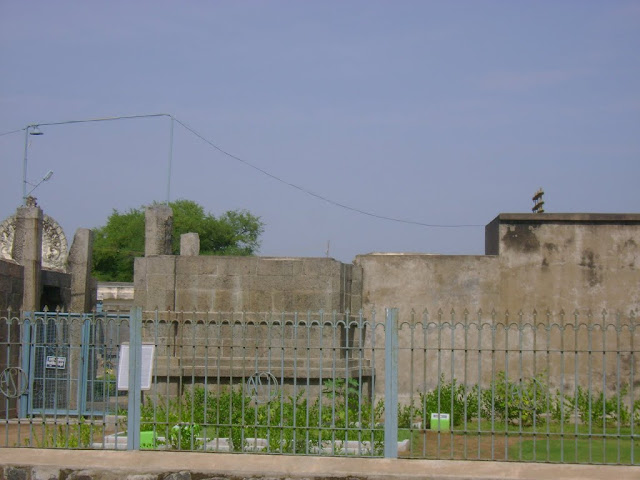Thiru Mukkoodal Appan Venkatesa Perumal Temple – The
Temple
This
unusual Pallava style temple built during 9th century A.D. is quite large and
appears to have included original plinth (padabandha adhishtana) a
sanctum (garbhagriha) and eka tala (single tier) vimana and the small pillared
porch (ardha mandapa). The vimana is built above a moulded plinth (adhishtana)
comprising 'upa-peeta,' 'upana', 'Jagati' , tripatta-kumuda' 'kantha' (with
'kampa'). The pada or external walls of the vimana surface have plain 'pathis'
or 'bhadras' and there are two central projections and 'koshtas' (niches) at
east and west walls, flanked by pilasters. Pilasters support the corbels
('potika') and architrave ('valabhi') above.
The
prastara or the roof-structure of the sanctum is the very simple form. The
oblong shaped single storeyed vimana built with brick. The pillared
hall serving as a portico for one or more small shrines. Six of the
pillars found at the pillared hall reminiscent of the distinctive Pallava type
with the shafts of the columns supported by the bodies of seated lions.
The pillared halls have Mahendra style, cubical top and bottom with
intermediate octagonal shaft. The cubical parts of the pillars are adorned with
bas-relief images as well as various designs. The pillars and shallow pilasters
carry on top massive corbels with beams.
Immense
contribution was made by the Chola and Vijayanagara rulers to the architectural
expansion of this temple complex. The entire temple complex - several mandapas
or pillared halls, bali-Peetam and Dwajasthambam (flag mast) - are enclosed by
the boundary walls. The unfinished east facing main entrance has only
the base of gopuram or tower which stands with two huge granite
walls (to bear the load distribution) but no towering roof present and
therefore known as Mottai gopuram.
There is a Vijayanagara style 16 pillared
hall with pillars adorned with exquisite bas-relief sculptures depicting the
various incarnations of Lord Vishnu, Mahalakshmi, Rama, Garuda, Hanuman and
saint Ramanuja.
The
main sanctum sanctorum of this temple, which faces north, houses the
imposing six feet tall stucco image of Lord Venkateswara, also known as Appan
Venkatesa Perumal in a standing posture with sage Markandeya and Bhoomadevi
seen meditating at his feet. The Lord faces the north and is in a standing posture.
The vimana above the sanctum sanctorum is of Sayana Vimana.
The idol is an
amalgamation of the Trimurti forms i.e, a manifestation of Shiva, Brahma
and Vishnu. The idol appears with crown looking like matted locks of Shiva; the
idol also has a third eye on the forehead. The left and right hands of the idol
holds Chanka (conch) and Chakra (discus), the weapons of Vishnu. The idol
stands on the lotus flower, the symbol of Brahma.
Lord Venkateswara
of Tirumala offered his Conch and Chakra to Raja Tondaiman Chakravarti and
saved the king and his kingdom from foreign invasion. Later Tondaiman
Chakravarti erected the same Conch and Chakra in the sanctum to glorify the
Lord. Lord is wearing a Salagrama stone garland made of 108 beads. As
the deity is the stucco image there is no Thirumanjanam (holy bath)
performed but only Thaila Kaapu.
The way
to the sanctum sanctorum is through a large-pillared mantapa. To its
right is a small shrine for Thaayaar (Goddess) Sri Alarmel Mangai Thaayaar facing
east. Also found in this mantapam are beautiful stone images of Hanuman, Garuda
and many of the Azhwars or the Tamil Vaishnava saints. The entrance to this
mantapam is supported by pillars typical of the Pallava style of architecture
with the lion base, reminiscent of those found in the Vaikunta Perumal temple
in Kanchipuram, capital of the Pallava kings.
There
are 3 Sthala Vrikshams (holy trees) for this temple, which are Devadhaari,
Vanni and Sandhanam (Sandal). Other deities like Sri Varadhar, Sri Aandaal and
Sri Anjaneyar (Hanuman) have separate shrines in the temple. Sri Anjaneyar is
very special here.
Whenever the Lord is carried out for procession, the first
respects are paid to Sri Anjaneyar before the God is taken out. Also Sri
Anjaneyar is said to be very powerful here in reducing the burden of one’s
debts.
People
worship Lord Anjaneyar here to come out of their heavy debts. Also peculiarly,
Anjaneyar is not offered ‘Vadai Malai’ here like other temples. Instead, he is
offered the garland made of ‘Thenkuzhal’ (a kind of Murukku snack). People pray
Lord Anjaneyar to come out of their debts and once their debts are settled,
they come here and offer ‘Thenkuzhal Maalai’ to him.
From
epigraphs it is learned that the Lord was also invoked with different names
such as Vishnu Bhatara (Pallava period); Thirumukkudal-Azhwar and
Mahavishnu (Chola period) and Venkateswara swami (later period). Also there are
shrines for Garudazhavar and Anjaneya. The Azhwars, the Vaishnavite saints also
appear in the circumambulatory path.



















































